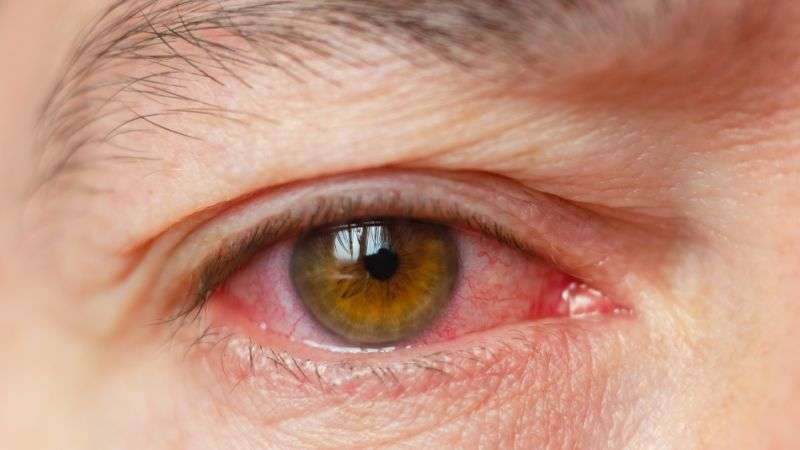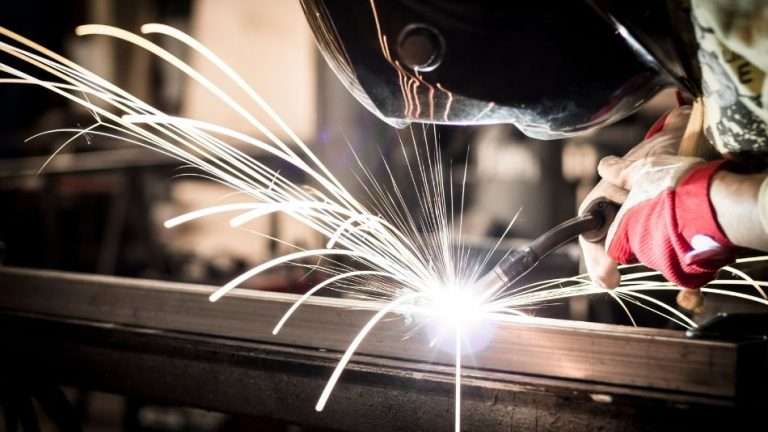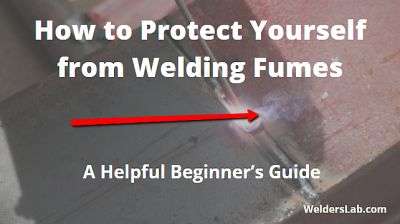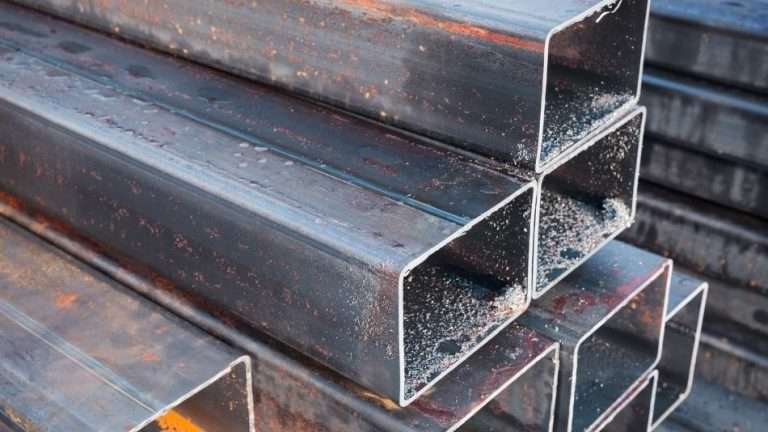How to Treat Welders Eye – A Complete Guide For Beginners

One of the worst things you can ever experience as a welder is burning your eyes. This recently happened to me, and it was extremely painful. If you’re wondering how to treat welder’s eyes, read on for all the remedies.
To get an idea of what this feels like, if you’ve ever gotten even one spec of dust in your eyes, you know how annoying that can be. But flash-burned eyes feel like someone just dumped hot sand in your eyes, only you can’t wipe them to get rid of them.
So how do you treat a welder’s eye? In most cases, a welder’s eye usually lasts one night, but in serious cases, it can last a few days. You may want to seek medical attention or talk to your doctor. In most cases, a cold rag and eye drops curb the pain until your eyes heal.
Quick note: Click here to check out the exact eye drop I use to treat welder’s eye.
One of the most common problems welders face regarding their safety is welder’s eye or welder flash burn. This is also known as arc eye. This guide will address this problem and how to prevent it or treat it if it happens to you.
What is welding flash burn?

A flash burn is when your cornea gets inflamed. It is very painful because it pertains to the clear tissue layer covering the front of your eye. Flash burns occur when you expose your eye to ultraviolet (UV) light in all its brightness.
Any UV light can cause this flash burn, but the most common source is welding torches. The flash burn is frequently called welder flash or arc eye.
These burns are about the same experience as sunburn on your eye instead of your skin. It can even affect both eyes. The good news is that your cornea is self-repairing and will heal within a few days. Usually, it will not even leave a scar.
If you do not treat the flash burn, it could lead to an infection that could cause vision loss, so it is very important to know how to take care of yourself and recognize the symptoms before it is too late.
These flash burns can affect both of your eyes at once. Make sure to treat them quickly to avoid vision loss and cataracts. Your cornea should be able to repair itself within two days if you take the right preventative and protective healing measures and allow your eyes to rest.
The cornea covers your iris and focuses light onto your retina. It also protects the deeper structures of your eye. Essentially, the cornea is like the windshield of the eye. The surface consists of cells similar to those found in the skin despite being clear in color.
How can you flash burn your eyes?
You can get a flash burn after you are exposed to UV light. Some different ways to get this type of burn are welding torches, direct sunlight, some lamps (like halogen bulbs or photographers’ flood lamps), sun lamps in tanning salons, or the reflection of the sun off snow or water.
Symptoms of flash burn can include but are not limited to:
- Feeling like sand, dirt, or dust is stuck in your eye
- Sensitivity to light
- Mild to severe pain that begins a couple of hours after welding
- Bloodshot eyes
- Blurred vision
- Watery eyes
To diagnose flash burns, you may need an eye exam.
This could include the doctor using anesthetic drops to numb your eyes. At the same time, you get examined, inspecting the area and eye for damage, and an orange dye test will show any damage that has occurred, which can be seen when using a blue lamp that will contrast with the orange dye.
This dye will wash away your tears without causing any harm to your eyes.
How to Prevent Welding Burns to the Eyes
The best offense is a good defense. You should always practice the recommended safety procedures to avoid and prevent welders’ eye and flash burns.
No matter what protective gear you use, you should avoid looking directly into the light of your arc as much as possible. Focus on your weld surface instead.
If you wear coated safety goggles, this can help protect your cornea from UV light. We recommend a full welder’s mask to prevent eye damage. Using an auto-darkening helmet will eliminate your risk of the welder’s eye almost entirely. Make sure any helmets and goggles completely cover your eyes.
Side Note: Never use a regular set of sunglasses to weld with. Welding requires at least a shade 10 lens in order to look at your welds. You can check out my complete article on welding lenses here.
These should protect your eyes from UVA and UVB radiation. Just make sure you check the label before buying sunglasses to be sure they can offer that protection.
How to Treat Welder’s Eye
If you suffer from this problem and need to know how to treat welding burns to the eyes, then we have a great answer.
#1 Over-the-Counter Eye Drops
I love Rohto Cooling Eye Drops All-In-One eye drops. These drops give a soothing and cool feeling in your eye when you apply them and treat eight different symptoms. I use them any time we end up with welder’s burnt eyes.
One of the reasons we recommend keeping Rphto Cooling Eye Drops on hand in case of emergencies is because they are very affordable and extremely effective. These will relieve the feeling of grit in your eye while reducing any watering and burning, or irritation from eyes.
The drop dosage works for up to 8 hours without needing reapplication. It is preservative-free, so you are not putting terrible materials that could aggravate your condition in your eyes.
The active ingredient in these eye drops is Hypromellose, a lubricant. It also uses Tetrahydrozoline HCl, a redness reliever, and zinc sulfate, an astringent.
Inactive ingredients include boric acid, edetate disodium, menthol, polysorbate-80, purified water, and sodium borate. Just remember to remove your contacts before applying these drops.
These strong eye drops will be quite a minty feeling because they cool and soothe your eye after a burn. These drops may be painful or uncomfortable if you are not used to handling this sensation.
Once the mint wears off, they offer a great soothing feeling to your eye. Just use your best judgment when balancing the pain with relief.
Side Note: If you wear contact lenses, you should immediately remove them to allow your corneas to rest and begin the healing process. If you experience light sensitivity, then consider wearing sunglasses so your eyes can rest.
You should see your eye doctor for their recommended care if the symptoms continue without improving.
Welder flash should be easy to cure with the right measures, but welding can be dangerous, so it is always best to check out unusual or long-lasting problems with a doctor to prevent more serious harm.
Dilating drops, like the ones we recommend, will relax your eye muscles and allow you to rest and heal without pain. This method will dilate pupils for a few hours to a few days.
#2 Talk to Your Doctor
You may need to cover your eye with a padded dressing to allow it to rest and heal. If you do, then do not drive. A doctor may prescribe antibiotics if your eyes become infected. This will usually be paired with an anti-inflammatory eye drop.
If you have blurry vision not caused by eye drops, worsening pain, a worsening glare, or any other unusual symptoms, you must seek medical help immediately.
If you use these eye drops, wash your hands before touching your eyes. Place your finger on your cheek and pull down your lower eyelid.
Then, tilt your head backward to drop the liquid behind your lower eyelid. If you use an ointment, smear a small amount along the inside of your lower eyelid without letting the nozzle touch your eye. Continue using these treatments until your eye has healed.
Review your symptoms in a day or two and ensure that your eyes are healing properly. Infections will take time, and you may need an ophthalmologist’s help if the eye drops and ointment don’t fix your flash burn within a couple of days.
You should seek immediate medical care if you experience pain that continually gets worse, blurry vision, or changes in your vision.
If you have these symptoms or flashing spots of light and pain with eye movement and can’t get to your eye specialist, you should go to an emergency room at a hospital for evaluation.
The emergency room physician or ophthalmologist will make their diagnoses after discussing your history, examining your eyes, and discussing the exposure your eye may have had during welding.
They will check your eyelids, pupils, vision, and the back of your eyes. They will use specialized equipment to examine the surface of your eyes.
A numbing eyedrop like the one we recommend above may be used to ease the examination process. A painless dye called fluorescein may also be used. This will temporarily stain your eye yellow or orange but disappear with normal tear ducts after a few minutes.
A damaged cornea will confirm their diagnosis of radiation eye burns or corneal flash burns. From there, they will prescribe a certain treatment method and recommend a follow-up examination in a few days.
#3 Prescribed Eye Drops
Some of the treatments they recommend may include cooling eyedrops, like the ones we recommend. They may also prescribe topical antibiotic eye drops or ointments made specifically for the eyes to prevent your damaged cornea from becoming infected.
Steroid eye drops may also be recommended if there is a case of excessive inflammation. These will prevent scars from forming.
They may also recommend a short-term drug that will paralyze the ciliary muscles in your eye. This will dilate your pupil and fix it in place. This drug allows your eye muscles to rest, and will also help to decrease eye pain and eye muscle spasms so your cornea can heal.
Oral medication can also be taken for pain relief. Anti-inflammatory drugs like Ibuprofen, Motrin, and Advil can be taken. So can non-steroidal anti-inflammatory drugs like naproxen, sodium, and Aleve.
Other pain medications like acetaminophen (Tylenol) can be used as well. Welders’ eyes will rarely need stronger pain medications.
Never use topical anesthetics for your eye. These can slow down the process of your cornea’s healing itself and cause ulcers to form in your eyes.
Following up 48 hours after your initial visit to re-evaluate your eyes will help ensure your cornea is healing properly.
Frequently Asked Questions
Here are some other common questions when people want to know about welder’s flash eye burns.
These are the biggest concerns and fears they possess after being exposed to arc flash. Hopefully, you will find any additional answers you seek here.
Can you go blind from welder flash?
It is possible to go blind from a welder’s flash, but it is unlikely to occur without prolonged exposure to the UV light source. The longer the duration of your exposure, the worse your symptoms and pain will be.
Most injuries from welding are preventable. 95 percent of arc injuries among welding professionals only see the welder take a week off work, and half of them return within two days!
Most people who get welder’s flash will realize it after a couple of hours. Because they are not welding for that long, the most they will usually experience is watery eyes, sensitivity to light, mild pressure or intense pain in their eyes, red eyes and membranes, feeling like there is sand or dust in their eye, or tearing in the eye and membrane.
However, prolonged exposure to UV light can also lead to more serious issues. Along with the length of exposure, the distance and angle of penetration also affect the severity. It is possible that you can end up with cataracts, which could, in turn, lead to a loss of vision or blindness.
If you are experiencing these symptoms, the best way to avoid blindness is by seeking medical care. Additional problems may contribute to your pain, and you may need antibiotics to prevent infections.
When you are diagnosed with welder flash burn, your doctor can treat you and allow you to rest and recover from home. You need to get a review two days after this begins to ensure you are healing properly.
Following this process should prevent any blindness. Your cornea should repair itself within a few days, provided you are treated quickly or take proper care of your eyes at home.
The outlook for the welder’s eye is usually very bright (no pun intended). The cornea can repair itself rapidly. In most cases, it will heal within two days without leaving scars.
This process will take only a day if you follow all the right instructions to protect your eyes against further damage and allow them the time and space to rest and heal.
Monitor the situation because not all potential arc eye and welder flash burn complications will appear immediately.
How close do you have to be to get welder’s flash burn?

Determining a safe distance to prevent the welder’s eye can be difficult. The radiation’s intensity and duratio,n and the penetration angle affect safety requirements and the likelihood of injury.
You can get an arc eye without even being the one welding if you’re too close to the area. This is why you need to observe all safety precautions.
The radiation intensity usually depends on the distance from the welding arc. If you are only a short distance from the arc, then even a short period of exposure to the arc’s flash can cause your eye to be injured. This is why wearing protection is necessary for the welder and anyone within 10 meters of the arc.
The intensity of the radiation will decrease as you move farther away from the source, but actively looking at the flash from any distance is still a bad idea because it can easily result in a flash burn.
Remember: This is similar to looking directly into the sun’s light, and Earth is significantly far away from the sun but direct eye contact will yield the same arc eye problem.
As a good general guideline, a rule of thumb that ophthalmologists recommend is to remain 60 to 100 feet away from the welding arc.
There is an exponential decrease in danger the farther you get from the arc. At 50 feet, the exposure would be almost fully mitigated if you do not look directly at the arc.
Despite this guideline, sources continue to disagree. The US Army carried out several trials that proposed any number of distances between 3 and 20 meters and experimented with exposure times of up to 10 minutes for MMA, (SMA), MAG (GMA), and FCAW to keep the exposure to the UV light below the US allowable daily threshold limit value.
Other sources continue to state that any radiation created from a welding arc has the potential to be hazardous to the eyes. Therefore, there can be no officially designated safety limit declared.
Therefore, the consensus remains that there is no safe distance to guarantee that you do not end up with a welder flash burn or dangerous exposure to the arc’s UV light.
The best current advice is to screen off your welding space using welding curtains to completely protect workers, civilians, and public members who are not properly equipped with adequate eye safety protection from the UV radiation that results from welding arcs.
How long does it take for welders’ flash to set in?
Welders’ flash will usually show up after a couple of hours. Because they do not show up immediately, it may be too late when you realize you have come down with an arc eye. This is why it is extremely important to protect yourself while you are welding.
Any time from 3 hours after exposure to up to 12 hours after exposure, you may notice flash burn symptoms. These symptoms may include excessive tearing, blurry vision, a feeling like dust or sand is stuck in your eye, bloodshot eyes, and mild to severe pain.
Quick Tip: I find once I know that my eyes are burnt its best to just keep them closed. Opening and closing your eyes will only irritate your eyes more.
In most cases, both eyes will feel these symptoms, though they are often worse in one eye than another. This is how you can differentiate arc burn from corneal abrasion, which usually only occurs in one eye.
Of the several times I’ve burnt my eyes welding, I usually start to feel its effects after I go to bed and way up at 1 or 2 am. At this point, I usually put more eye drops in and get a cold rag to put on my eyes.
If I don’t like medications or drugs, are there any natural remedies to treat the welder’s eye?
A lot of people want to care for their eyes at home without seeing medical care or buying drugs. If this sounds like you, you may still have some options.
#1 Milk

A drop of milk can work wonders. If you have not heard of using milk to treat skin burns, it has been used for years as a soothing remedy. It can work well for the arc eye, too.
The natural enzymes contained in the milk can treat your itchy eyes while soothing the surface and reducing inflammation.
Boil the milk first, then allow it to cool to room temperature. Dip a cotton ball in the cool milk and gently touch the affected eye. After 3 minutes, gently rinse the eye.
#2 Teabags
Teabags may also help. Many teas contain antioxidants, which can soothe inflammation and counteract pain. It can also have the added benefit of reducing puffy eyes and dark circles!
#3 Cucumbers

Similar to teabags, cucumbers are also a great option. It has huge cooling power and works as a great lubricant due to the high volume of water.
. This can deeply moisturize your burn area and soothe any itchiness and dryness while rehydrating your flash burn. Take two thick slices, refrigerate for a few minutes, then put them on your eyes!
#4 Rosewater
Rosewater can also help treat irritation caused by welder’s flash. The cooling sensation and hydration can reduce your itching and swelling. Soak a cotton ball in rose water, place it over your affected eye, and leave it there for 10 minutes.
#5 Potatoes

For an earthier option, try potatoes! No, I am not joking. Surprisingly enough, potatoes work wonders when treating welder’s flash.
They reduce inflammation and itching around the eye. Grate the potatoes and place the grated potato on a wet cloth. Put the wrapper in the refrigerator for about 5 minutes, then place the wrapper on your eyes. Keep it on for 10 to 15 minutes.
#6 Aloe Vera
Finally, aloe vera can help your eyes much like it relieves sunburns on your skin. This plant stores a ton of water in its leaves.
It contains antibacterial and anti-inflammatory properties that make it ideal for use because it can reduce pain while preventing infections.
Mix two tablespoons of fresh aloe vera gel in cold water and soak some cotton rounds. Then, place the soaked cotton on your affected eyes for 10 minutes.
Conclusion
Welder eye, also known as flash burn and arc eye, can occur for anyone who gets too close to the arc flash of a welder’s ultraviolet light without wearing the proper protection.
Direct exposure for short periods can damage your cornea, causing infection and inflammation.
It will take a couple of hours to set in, so it can often be difficult to know until too late that you are suffering from an arc eye.
Once you have discovered this, thanks to symptoms like eye pain, watering, and blurring, you need to get some cooling drops and allow your eyes to rest for a few days.
After the time of rest and eye drops, consult your ophthalmologist. Welder’s flash should heal itself in 48 hours, so if your cornea hasn’t healed, you may need antibiotics and additional treatment.
Only a professional can diagnose this. It is always best to be prepared. Ensure you observe your safety precautions when welding, including wearing the appropriate helmet and eye shields. We recommend having some Rohto Cooling Eye Drops on hand in emergencies!






